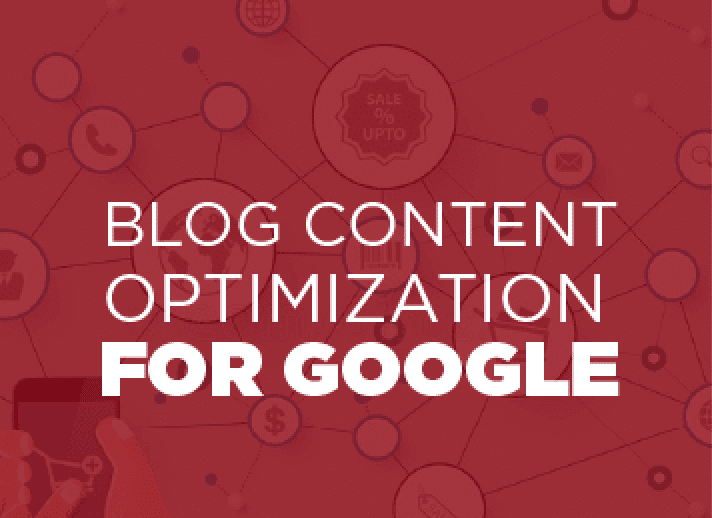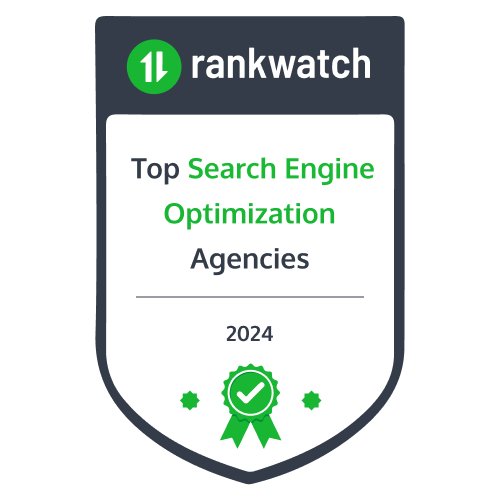
How To Optimize Blog Posts For SEO
[And Rank On Google In 2024]
Optimizing your blog for SEO to improve its ranking on Google and other search engines is one of the most fundamental aspects of blogging. Search engine optimization does indeed make your website more visible and relevant to search engines and their users. It ultimately goes on to improve your blog’s organic traffic, prospective leads, and conversion rates.
In most cases, e-merchants who do not benefit from their blog are not employing SEO best practices. This, in turn, results in content that never ranks on Google and, therefore, is a significant waste of time. To make the most of your investment while crafting blog posts for your business or even for yourself, you need to do it the right way.

In this guide, we’ll explore the most effective and efficient techniques to optimize your blog for SEO from different perspectives, so that your site can rank highly in Google searches. Let’s dive in.
What Is An SEO-Friendly Blog?
An SEO-friendly blog is essentially a blog that is optimized to rank higher in search engine results. Think of it as making your blog easier for Google and other search engines to understand. The process involves using the right keywords, crafting engaging and informative content, and making sure your site is user-friendly.
An SEO-friendly blog not only draws traffic but also attracts the right kind of traffic – people who are genuinely interested in what you write about.
How Does Blogging Help With SEO?
Blogging can be a powerful tool for both directly and indirectly boosting your SEO in several ways. Let’s look at some of those –
Google Prioritizes Fresh Content:
Most search engines, including Google, love new pieces of content. Regularly updating your blog with fresh articles and other types of content gives search algorithms more reasons to index your site more often, which can help improve your ranking.
Capitalizing On Keywords:
Each blog post is an opportunity to target specific keywords relevant to your niche. By naturally incorporating these keywords into your content, you can help search engines understand what your website is about. The machines will then find it easier to match it with search queries.
Leveraging Internal Linking:
Blog posts allow you to link to other parts of your website. It helps search engines understand the structure of your site. It can also keep visitors on it longer, which reduces bounce rates.
Attracting More Beneficiary Backlinks:
Quality articles or blog posts can draw in links from other websites. These are called backlinks, which act like votes of confidence from other sites. The authority of backlinks is telling search engines that your content is authentic, valuable, and trustworthy.
Facilitating Broken Link Building:
Another means by which a blog can help with SEO is through a method called broken link building. It is basically searching for backlinks that have become broken on the internet due to their original destinations being altered, moved, or expired. You’ll then inform the webmaster and propose similar relevant content as a viable replacement.
Increasing Engagement:
Good-quality blog content encourages readers to spend more time on your site and interact with your posts. They can even share your content on their social media accounts or send it to their friends. Higher engagement gives a signal to search engines that your webpage is a valuable resource.
13 Professional Tips To Optimize Blog Posts For SEO:
A major step you can take in optimizing your business website is to start a solid blog. However, as with all things, you’ll need to understand how to do it right to make it worth the effort. You don’t have to worry because we can help you with some pro tips.
Here are 13 most efficient Google Optimization tips that you should consider for every blog you write to ensure they make the biggest difference in your rankings in SERPs:
Start With A Fantastic Domain Name:

The very first thing you need to do to start blogging is to choose the domain name for your blog site. While you do so, keep the following things in mind –
- This name can not conveniently be changed later on, at least not without giving up several of the branding you’ve built up by that point. Therefore, if you want to link the blog site to an existing brand name, ensure that it shares the name.
- If you’re just starting as an entrepreneur, it’s rather wise to consider what your brand will go on to become, if you are likely to have one in the future. If you are not exactly sure, opt for something that is unique and communicates some of the sensations, values, and special qualities of the niche you’re intending to write for.
- When brainstorming innovative alternatives, don’t forget a crucial situation that you might face over and over again – having to state the name verbally. To avoid future stress, try to keep the name easy to pronounce.
- Keep the name short and easy to remember. It’ll give you an upper hand in attracting more visitors, especially, if you’re actively marketing and networking. These precautions help prevent the unwanted scenario of a potential contact forgetting about your blog shortly after you’ve told them about it.
- Including your keyword phrase in your domain name only helps if it makes sense for your brand. Don’t force it, or you could even face penalties.
- Resist the urge to hyphenate. Hyphens can harm Search Engine Optimization and make it harder to type from memory.
- Make sure that your name is unique and distinct from existing ones. Otherwise, you’ll compromise your SEO compared to them.
If you start your blog off with a fantastic name that adheres to all the aforementioned advice, you’ll have a head start on several other businesses.
Identify The Keywords To Focus On:

It’s always a good idea to begin every big task with a solid plan. One aspect of this is defining and scheduling a series of smaller tasks, such as daily or weekly blog content publishing. The best way to start is by selecting the keyword phrases you want to target before composing any actual drafts.
While the keywords you choose will certainly depend on your industry and subject, determining which ones make the most sense will nonetheless need the following considerations –
- Analyze your competitors to see what they’re targeting.
- Opt for what’s likely to be unique. Ask yourself, ‘What will make my content stand out?’
- Set a keyword budget and spend accordingly.
Produce Great Content Material:

The concept of SEO is heavily dependent on developing premium-quality content. Technically speaking, it has to do with maintaining the density of your keywords in each blog post and the inclusion of complementary content such as images and videos whenever possible.
The final ‘big’ technical step is to encourage other websites to link back to your articles so that you can successfully build domain authority. Nevertheless, remember that producing high-quality content is much more important than many other tasks.
Ensuring that your blogs can be reviewed by search algorithms is necessary. But it’s also important that people find value in them when they read them. This way, readers will want to refer back to your content and your blog will become successful.
It will be fairly difficult to get another website to link back to yours if you don’t invest in high-quality text, pictures, and videos. Additionally, a high bounce rate, where individuals leave after 30 seconds or less due to disappointment, is a sure path to dropping search rankings.
Write A Compelling Blog Post Title:
Crafting a compelling title for your blog post is the top-notch way to create a perfect first impression. It should be something that grabs your reader’s attention immediately. A great title not only draws readers in but also gives search engines a clear idea of what the post is about.
Here are some tips to make a post title irresistible –
Crystal Clear And Specific:
Your title should clearly convey what the post is about. Avoid being vague or oversmart. Remember that straightforward titles perform best.
For example, “10 Tips for Growing Basil Plants Indoors” is a great title. It’s clear and to the point.
Incorporate Targeted Keywords:
Use relevant keywords that your audience might be searching for. It’ll boost your article’s visibility on search engine result pages. However, make sure that the title still sounds natural and engaging.
Induce Genuine Curiosity:
Hook readers giving them a little hint regarding some useful information contained inside the post. You can be harmlessly mysterious and moderately playful but don’t overdo it.
Titles such as “The Secret To Perfect Pancakes” and “Why You Are Not Losing Weight [And How to Fix It]” are likely to make Google users want to know more.
- Add Numbers At The Beginning Of The Title:
Titles that start with numbers often rank high on SERPs and gain more attention because they promise specific, precise, and digestible content.
Let’s look at the examples – “5 Easy Steps to Start A Blog”, “7 Surprising Benefits of Meditation”
Keep The Title Concise And Calculated:
Try to come up with a title that is short but descriptive. The best SEO practice is to keep an article/ blog post title under 8 words, or 60 characters so that it doesn’t get cut off while being displayed in search engine results.
Experiment With Alliteration:
Alliteration means the repetition of the initial consonant sounds in two or more neighboring words or syllables. It can be a cool method of spicing up a title without being intrusive.
“Fiberglass Flooring For Farmhouses: Fashionably Futuristic” is an example of a title that effectively uses alliteration.
Add SEO-Optimized Images And Videos:
Using images, videos, infographics, etc can make your blog posts more engaging and boost SEO. Follow these suggestions –
- Use relevant keywords in the file names and alt text.
- Compress images to speed up load times and ensure videos are high quality.
- If your media files are optimized for search engines, the algorithm will be able to detect your content easily and promptly. It will also keep readers interested along the way.
Link To Related Blog Posts:
Linking to related blog posts not only assists search engines in dissecting your site’s structure but also keeps readers engaged. It allures visitors to explore more of your content which over time boosts page views and reduces bounce rates. Plus, it shows search engines that your website has a lot of valuable, interconnected content.
Optimize The Meta Description:
A well-crafted meta description can improve click-through rates from search engine results. Here’s how to do it –
- Write a brief, interesting, and precise summary of your post.
- Make use of relevant keywords naturally in the summary.
- Keep it under 160 characters to ensure that it displays fully.
An effective meta description entices the viewers to click and read your post.
Update Existing Content:
Regularly updating the existing content on your webpage can improve its relevance and SERP ranking. Try these suggestions –
- Refresh outdated information
- Add new insights
- Check for broken links
Continual content updates notify search engines that your content is current, fresh, and noteworthy. This will boost your blog site’s online presence and attract more readers.
Optimize For SERP Features:
Optimizing your content for SERP features facilitates getting into rich snippets, knowledge panels, and answer boxes by providing clear, concise, and accurate answers and using structured data. This makes your content more attractive and accessible in search results.
Generate User-Friendly URLs:
User-friendly URLs are short, descriptive, and easy to read. You need to incorporate relevant and high-quality keywords in it for Google to understand your content. Avoid long and complex strings of numbers and characters.
A clean and precise URL like “yourwebsite.com/healthy-breakfast-recipes” is likely to do better in appealing to both users and search engines.
Noindex Category And Tag Pages:
No-indexing category and tag pages can prevent low-quality, duplicate content from affecting your SEO. These pages usually don’t provide substantial value but rather dilute your keyword focus.
Use your site’s settings to tell search engines not to index these pages. Doing so will keep the focus on your main content.
Monitor Your SEO With Search Console:
Google Search Console is a powerful tool for tracking search engine optimization performance. It works to identify SEO issues, monitor keyword rankings, and analyze how Google perceives your blog.
Regularly check your Search Console if you want to stay on top of your SEO health and make informed improvements.
Optimize Your Posts For Featured Snippets:
To optimize for featured snippets, incorporate clear and concise answers to related common questions within your article. Make correct use of headings, bullet points, numbered lists, tables, etc, to increase content readability.
Structuring a blog post this way fosters the chances of Google selecting your post for a snippet and driving more traffic to you.
Factors That Affect Blog SEO:
When it comes to getting noticed by Google, Bing, and other search engines, there are several key factors that either make it or break it for you. These elements play a role in making search engines decide how useful and relevant your content is. This decision ultimately affects where your content appears in search engine result pages.
Let’s break down some of these factors –
Dwell Time:
It refers to how long a visitor typically stays on your page after clicking on it from a search engine results page (SERP). If people are sticking around and reading your content, it’s a good sign indicating that your blog is adding substantial value.
To maximize dwell time, put an effort into creating useful, engaging, informative, and well-organized content. Determine what your target audience is looking for and make sure you’re delivering it in an easy-to-read manner.
Page Speed:
Page speed is all about how quickly your blog loads. In today’s fast-paced world, nobody likes to wait for a slow website. If your blog takes too long to load, visitors might leave before they even see your content.
Search engines take this into account, so it’s crucial to optimize your page speed. Simple ways to do this include –
- Compressing images
- Using a reliable hosting service
- Minimizing the use of heavy scripts
Mobile Responsiveness:
With more people browsing the internet on their phones, having a mobile-friendly blog is pretty much quintessential. Mobile responsiveness should be taken care of very well because it ensures that your site looks and functions smoothly and quickly on all devices including smartphones and tablets.
These 3 actions will make sure that your blog is mobile-responsive –
- Use a responsive design theme.
- Check your site’s performance on different devices.
- Make sure your content is easily navigable on smaller screens.
Remember that Google, Bing, etc, prioritize mobile-friendly blogs in their rankings.
Index Date:
The index date is when search engines first discover and catalog your blog post. While newer content can sometimes rank higher because it’s fresh and current, older posts can still perform well if you update those on a regular basis.
Therefore, a blog owner should make it a habit to revisit and refresh their older posts with new information, updated links, and up-to-date SEO practices. This way, both your new and old content can continue to attract and engage visitors.
Recent Data:
Add new information as it becomes available, replace outdated statistics with current ones, and make sure any links you include point to the latest resources. This ongoing maintenance is necessary so that your webpage remains a reliable and valuable resource for internet users and continues to rank well in search results.
Bottom Line:
At the end of the day, your blog is for your targeted audience who may turn into loyal readers and/or customers today or tomorrow. So, prioritize their needs and provide them with considerable value.
Hopefully, following the Google optimization tips shared in this article will help your blog content ace the ever-evolving SEO game.
Be visitor-obsessed and give your best efforts to deliver an exceptional consumer experience, and with time, the numbers will follow.
Learn more about Hong Kong Google Optimization.
Frequently Asked Questions:
How Often Should You Blog For SEO?
If you’re committed to creating diverse, impactful, quality content, how frequently you publish a blog post depends on the nature of your business, niche, and workforce. A good approach to start would be once a week. If this seems inadequate, try twice or three times per week.
Remember that consistency is more important than quantity. You can try setting a schedule and sticking to it.
It’s always better to plan ahead of time to ensure that you’ve got a steady supply of useful, engaging, industry-specific content to attract and captivate your preferred target audience.
What Are The Best Practices For Encouraging Social Sharing Of My Blog Posts?
Here are some tips to increase social sharing of your blog posts –
- Create content that makes your audience willing to share. You can write about trending topics, evergreen topics, or just anything that you believe has the ability to compel people to share with their friends, colleagues, or social followers.
- Make your content easily shareable by adding social media sharing buttons. It’ll then be much easier for the readers to share your blog post.
- Use a content curation platform that suggests content to its users depending on their needs. You can either choose a manual service in which you’ll be submitting content yourself or an automated alternative in which the service handles everything for you.
Do Blogs Help With Google Ranking?
Yes, an optimized blog certainly improves your brand’s Google ranking. It helps with SEO and here’s how –
Great blogs provide relevant, authentic, and reliable information that search engine users are looking for. Therefore, if you can create one and the visitors are satisfied with it, the increased traffic your website gets from them will heighten your position in SERPs. On top of that, it drives organic traffic and high-quality leads.




